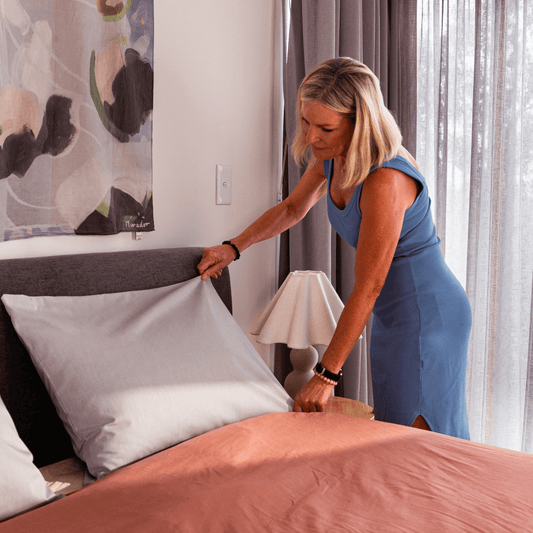
How Long and How Often Should I Do Grounding?
Denzel SueltoGrounding is when you make direct contact with the Earth, like walking barefoot on grass, swimming in natural water, or using grounding tools.
Many people include grounding in their daily routine, but figuring out how long and how often to do it can be confusing.
Some say a few minutes is enough, while others swear by hours of daily grounding.
The truth is—it depends on your lifestyle, health, and how grounding makes you feel.
Quick Key Takeaways
- Even short grounding sessions (20–30 minutes) can deliver noticeable benefits.
- Daily grounding is recommended for consistent health improvements.
- Longer sessions (1–2 hours) may provide deeper relaxation, circulation, and inflammation reduction.
- People new to grounding should start with shorter sessions and gradually increase.
- Both frequency and consistency matter more than exact duration.
- Indoor grounding mats and sheets allow for extended grounding while sleeping or working.
- Safety should always be prioritized—choose safe environments and consult a doctor if on medication.
How Long Should You Ground Yourself Each Day?
You should aim for at least 30 minutes a day of grounding to feel noticeable effects.
Most of our customers start with 10 to 20 minutes and gradually increase their time based on how they feel.
The longer you stay connected to the Earth, the better, but even short sessions can be beneficial.
Is 10 minutes enough?
Yes, 10 minutes of grounding is better than nothing, especially if you do it consistently.
Some people feel a difference after just a few minutes, while others may need more time. If you’re short on time, try multiple short sessions throughout the day.
What’s the ideal grounding time?
For most people, 30 to 60 minutes per day is a good goal.
If you have specific health concerns or high-stress levels, spending more than an hour might be even better.
If you’re using grounding mats or sheets indoors, you can stay grounded for several hours or even while sleeping.
Can you ground too much?
There’s no evidence that too much grounding is harmful. Some people stay grounded all day by using mats, sheets, or grounding footwear.
It really comes down to what feels good for you.
How Often Should You Practice Grounding?
You should aim to ground yourself at least once a day for 30–60 minutes to get the most benefits.
If that’s not possible, try a few times a week for at least 20 minutes per session. The more often you ground, the more noticeable the effects can be.
Should you do grounding every day?
Yes, daily grounding is ideal, even if it’s just for 10–15 minutes. If you can step outside barefoot in the morning, sit on the grass during a break, or use a grounding mat indoors, you’ll maintain a consistent connection to the Earth.
If you can’t ground every day, aim for at least 3–4 times a week. Occasional grounding is still beneficial, but consistency makes a bigger difference.
Are multiple short sessions better than one long session?
Both approaches work, but shorter sessions spread throughout the day can be more effective.
Here’s how you can fit grounding into your routine:
- Morning: Walk barefoot for 10–15 minutes on grass or soil.
- Afternoon: Take a 5-minute barefoot break outside or use a grounding mat while working.
- Evening: Sit or lie on the ground for 20–30 minutes or sleep with a grounding sheet.
If you prefer longer sessions, aim for at least 30–60 minutes straight, ideally while sitting, lying down, or walking barefoot.
Do some people need more grounding than others?
Yes, some people benefit from longer or more frequent grounding, especially if they experience:
- High stress or anxiety – Try grounding twice a day for 20–30 minutes each.
- Chronic pain or inflammation – Aim for 1–2 hours daily or sleep on a grounding mat.
- Limited outdoor time – Use indoor grounding tools to maintain a consistent connection.
- City living or high EMF exposure – More frequent grounding can help balance the effects of modern environments.
If you’re new to grounding, start with 10–20 minutes a day and adjust based on how you feel.
What’s the Best Time of Day for Grounding?
The best time to ground depends on your routine and what you want to achieve.
Some people prefer grounding in the morning to wake up naturally, while others do it in the afternoon to reset or in the evening to relax before bed.
Morning Grounding – Best for Energy and a Positive Start
Grounding in the morning helps wake you up, boost your mood, and improve focus for the day ahead.
A simple way to do this is to step outside barefoot for 10–20 minutes while drinking your coffee, stretching, or just enjoying the fresh air.
If you’re indoors most of the day, grounding in the morning gives you an early dose of nature and sunlight.
Afternoon Grounding – Best for a Midday Reset
If you’ve been sitting indoors for hours, working, or staring at screens, grounding in the afternoon can help reduce stress, improve circulation, and refresh your mind.
A 10–15 minute barefoot walk on grass or sand works well, but even a few minutes of standing outside barefoot can make a difference.
Evening Grounding – Best for Relaxation and Better Sleep
Grounding before bed can help you relax, lower stress, and sleep better.
Spending 20–30 minutes sitting or lying on the grass is ideal, but if that’s not possible, you can use a grounding mat or sheet indoors.
If you struggle with sleep, try making evening grounding part of your wind-down routine.
Reconnect Once Again With Mother Earth
The best grounding routine is one that fits into your daily life. If you’re just starting, aim for at least 20–30 minutes a day and see how you feel.
Benefits often come into your body as little as 10 minutes and many people seem to like multiple sessions to maximise them.
If you can’t ground outside often, grounding mats or grounding bed sheets are a great way to stay connected indoors.
References
Chevalier, G., Melvin, G., & Barsotti, T. (2015). One-hour contact with the Earth’s surface (grounding) improves inflammation and blood flow: A randomized, double-blind, pilot study. Health, 7(8), 1022-1059. doi:10.4236/health.2015.78119
Lin, C.-H., Tseng, S.-T., Chuang, Y.-C., Kuo, C.-E., & Chen, N.-C. (2022). Grounding the body improves sleep quality in patients with mild Alzheimer’s disease: A pilot study. Healthcare, 10(3), 581. doi:10.3390/healthcare10030581
Ober, C., Sinatra, S. T., & Zucker, M. (2012). Earthing: Health implications of reconnecting the human body to the Earth’s surface electrons. Journal of Environmental and Public Health, 2012, Article ID 291541. doi:10.1155/2012/291541










